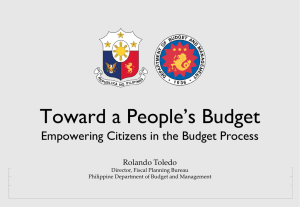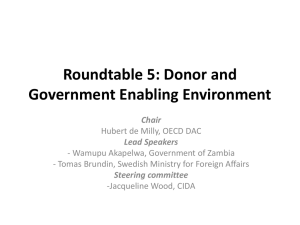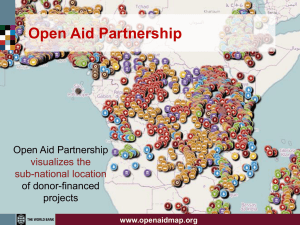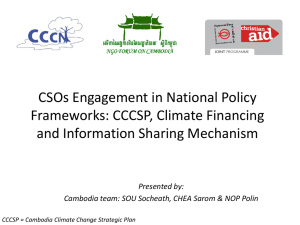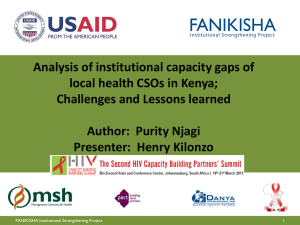Lessons from comparative research on public participation
advertisement
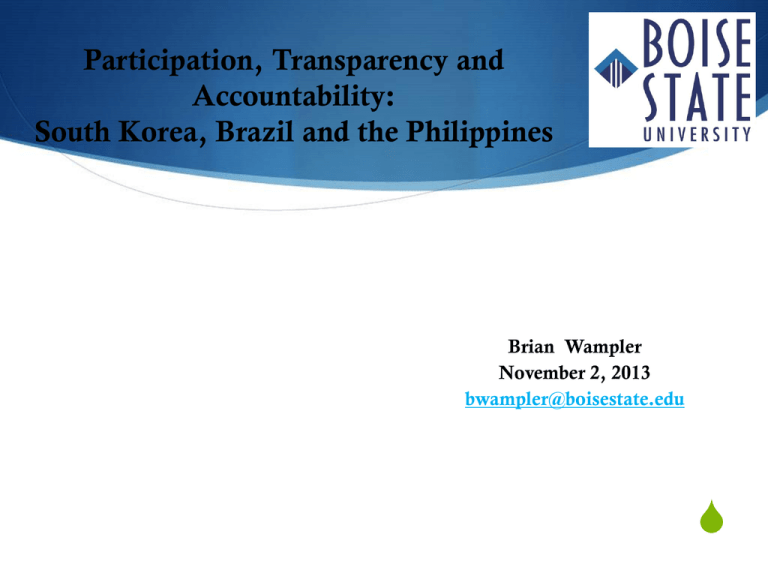
Participation, Transparency and Accountability: South Korea, Brazil and the Philippines Brian Wampler November 2, 2013 bwampler@boisestate.edu S Rebuilding state institutions: incorporating both participation and transparency mechanisms S What is the “PROBLEM” that participation is meant to solve? S Institutional development will vary significantly based on moment of intervention in policy cycle S Policy formulation S Policy implementation S End-of project-Auditing S Carefully linking the political and policy interests of government officials (supply-side) and citizens (demand-side). Supply-side S What types of authority are government officials willing to delegate to citizens? What is the level of risk acceptable to government officials? S Key issues to be considered: S Use of multi-channel forums (in-person, online; consultative, binding) S Engage citizens and CSOs at multiple stages of the budgetary cycle S Cover a range of policy issues (education, basic infrastructure) S Interlocking Institutions (Federal, across policy arenas, multi-channel S Retrain public servants and technical experts to work directly with citizens S Reward local Governments and country-level agencies to work directly with citizens Demand-side S Demand-side: How will citizens and CSOs be able to use newly delegated authority? Can citizens simultaneously pressure and partner with government officials? S Citizens have formal opportunity to exercise some combination S voice, vet, vote and veto S Include citizens and CSOs in discussions about the problems that the new institutions is designed to solve S Build capacity among CSOs S Provide meaningful feedback loops S Auditing and Monitoring can be carried out by citizens and CSOs Range of participation S Voice: The ability of citizens to express ideas, preferences, and opinions within and parallel to formal state-sanctioned bodies. Civil Society Organizations (CSOs) can also represent citizens’ voice S Vet: The ability of citizens and CSOs to review documents and information provided by government officials. Better quality vetting produces more informed voice S Vote: Citizens vote on policy proposals that emerge from civil society or from the government. A “binding” vote would be the strongest form of vote; it entails a public vote being translated into direct action. A “consultative” vote might be on general policy lines. S Veto: Citizens and citizens have the authority to reject policy proposals, year-end reports, and audits. Open Budget Survey, Participation Indicators 2006 2008 2010 2012 Brazil 50 60 60 36 Croatia 33 33 40 36 El Salvador 33 53 47 14 Indonesia 0 7 7 19 Jordan 0 27 13 11 Kenya 17 33 73 39 Mexico 33 27 53 25 Philippines 50 47 67 53 South Korea 84 80 93 92 Tanzania 0 40 0 14 UK 50 67 67 56 US 84 87 87 58 Ethiopia Moldova S South Korea, Brazil, Philippines S South Korea: Institutional Restructuring and Expert- based participation S Brazil: Mass-based participation and multi-channel state-building S South Korea: Rebuilding the state with mixed forms Participation and Oversight Open Budget Survey, 2012 Participation South Korea Brazil Philippines Overall Score on Index 75 71 48 Participation Score 92 36 53 Formal requirement for public participation Exists and is strong Exists but could be improved Exists but could be improved Mechanisms developed by the executive for participation during budget planning Exists but could be improved Exists but could be improved Exists but could be improved Mechanisms developed by the executive for participation during budget execution Exists and is strong Does not exist Exists but could be improved Feedback by the executive on use of inputs provided by the public Exists but could be improved Does not exist Exists but is weak Key Similarities South Korea Brazil Philippines Year of new Constitution 1988 1988 1988 Decentralization 1995 1988 1991 Renewal of civil society Labor and student opposition during late 1980s Mass-based opposition to military regime during 1970s and 1980s Mass-based opposition to President Marcos during 1980s Key Differences South Korea Brazil Philippines State Capacity Strong Mixed: Significant variation in state capacity across regions and policy sectors Mixed: Significant variation in state capacity across regions and policy sectors Social cleavages Low Moderate to High High HDI, 2012 .909 .730 .654 Civil Society Technical Capacity at time of Democratic Transition Moderate to low Moderate to Low Low Current Civil Society Technical Capacity High Moderate Mixed—Small cluster of NGOs with high capacity South Korea: Institutional Restructuring and Expert-based participation Three Plus One Fiscal Reform (2004) S South Korea: Distinguishing Features S Digital Brain: Leveraging IT to provide timely and easy to manage information S Extensive formal opportunities for expert-based participation S Participation largely involves policy experts and NGOs appointed by government officials S Local governments, encouraged by President Roh (2003-2008), promote “ordinary citizen” participation. Participatory Budgeting is used by local governments Korea: Key Outcome Brazil: Mass-based participation and multi-channel state-building S Participatory Budgeting (Subnational, mainly municipal) S 100+ cities adopt; billions of US dollars spent on PB projects S Public Policy Management Councils (Federal in structure) S 65,000 with 300,000 elected citizens-volunteers S Policy Conferences (Federal in structure) S 83 since 2003; 6-7 million participants S Multi-year Planning process (Federal, state, municipal) S 19 national councils + 350 civil society Brazil: Distinguishing features S Multi-channel approach; wide diversity of issues S Mirrors Brazil’s Federal structure S Mass-based participation; elections used to select civil society representatives S Limited formal access to federal budgetary processes Brazil: Outcomes S Participatory Budgeting S Increase in spending on health care, sanitation; decrease in infant mortality; Effects grow stronger over time (Touchton and Wampler, forthcoming) S Public Policy Management councils S National-level councilors shape Federal policies, both at proposal and implementation stages (IPEA 2012) S Policy conferences S Holding conferences increases Presidential Decrees is policy arena (Pogrebinschi) S Multiyear Planning Process S Projects proposed by CSOs are included 4-year Planning document (Teixeira) Philippines: Rebuilding the state with mixed forms Participation and Oversight S Cabinet Cluster on Good Governance and Anti-corruption S Seal of Good Housekeeping (Race to the Top for municipalities) S Budget Partnership Agreements (Agency-CSO agreement) S Bottom-up Budgeting Approach (Poverty reduction S Citizens’ Participatory Audits CSOs Philippines: Distinguishing Features S Mix of citizens and policy expert participation S Reform at both local and country-level S Effort to empower citizens and CSOs S Participatory Auditing is important; Extensive effort to limit corruption Philippines: Outcomes S Recent reform efforts: Too new to evaluate Earlier reforms S Community-Driven Development (World Bank) S Increased participation S Empowerment-oriented S Monitoring programs led by CSOs S Reducing corruption S Local level (Naga city) S Increases in Participation Voice, Vet, Vote and Veto South Korea Brazil Philippines Voice Expert; Policyoriented Mass-based + elected volunteers Vet Robust Exists and is getting stronger Mass-based + elections of CSOs + Expert CSOs Exists and is getting stronger Vote Exists for policy experts; Exists but is very weak for ordinary citizens Exists at local level (PB); Consultative vote in councils and conferences Exists at local level Veto Non-existent Exists but is weak Exists but is weak 4 Key lessons S Political Will: Election of political reformers to presidency is crucial because it creates necessary political will to implement reform; In all three countries, the president’s political coalition established the contours of reform. S Civil Society: Renewal (increased density + new actors and issues) of civil society increases attention on basic governance issues; Engaged CSOs provides necessary partners for government reformers S State Capacity: The degree of state capacity strongly affects the type of reform undertaken and the pace of reform. We should expect more limited measurable effects when state capacity is weak. S Direction of change: The shape of institutional rebuilding is strongly affected by the political and geographic source of reform. Topdown/Center-periphery reforms are distinct from bottom-up/perhipharycenter reforms. Key Lessons: Demand-side S Elite-based model S Improves quality of debate; produces more equal negotiating partners; Allows government and civil society to check power of entrenched business groups and bureaucrats S Key problem: Selection of policy experts; Independence of policy experts S Mass-based model S Expands public debate and range of issues discussed; Promotes empowerment but CSOs remain at information and knowledge deficit S Key problem: General debate rather than specific details S Mixed model S Empowers citizens and CSOs; allows for a variety of venues to participate; promotes a wide-range of actors S Key problem: What is the basis for different types of representation? Key Lessons: Supply-Side S Governments and CSOs need to first identify the “so-what” problem that participation and transparency-oriented reforms would solve. S Country-level government can incentivize improvements in governance by rewarding local governments and agencies that introduce new programs and policies S Establishing formal institutions is first step; ensuring CSOs and citizens can make meaningful use voice, vet, vote and veto is step two. S Participation can included at multiple stages depending on the problem that government Other Participation Reforms S Community-Driven Development (World Bank): S “An approach to local development that gives control over planning decisions and investment resources to community groups (including local governments).” CCD core course S International Labor Organization Convention 169 (UN agency S S Establishes Prior, informed consent for Tribal and Indigenous Populations over local development issues 22 countries have ratified S Audits: Participatory and Social S Participatory Budgeting: Thousands of cities and districts across world S Citizens directly engage each other and government officials in the allocation of a small percentage of the government’s local budget. Community-Driven Development S Indonesia (KDP)-:Villagers submit proposals to community coalitions of nominated village facilitators. Participants vote for specific projects. All transactions public with citizen engagement from planning to implementation. S Benin: Projects selected by elected management committees and tied to ministries to direct in policy and information-sharing. S Azerbaijan: Sub-projects proposed by local CSOs, community selects for implementation. Regional coordination is half CSO and half government for information, expertise, monitoring Scaling-Up: Expanding CDD in Indonesia S Original Kecamatan Development Program expanded in 2007 National Program for Community Empowerment in Rural Areas S Nation-wide coverage with over 5,000 kecamatans and over 34 million beneficiaries S Since the first KDP has “financed over 109,000km of small roads, 17,000 bridges, 40,000 clean water systems S Increased upward mobility in PNPM areas (2.1%), real per capita consumption gains in PNPM areas (9.1%), Participatory Budgeting Peru S Project Context S 2003 national Participatory Budgeting Law requires all municipal-level districts (1821) to use participatory budgeting processes S Methodology S National government spearheading PB well-positioned to innovate at local level S All districts form local coordination councils to implement participatory budgeting programs; All Districts form Oversight committees, which is geared toward enhancing social accountability over the implementation phrase S Results S A few key districts (municipalities) have produced robust results. Most districts have produced limited results due to limited civil society participation; Most participation involves CSO representatives rather than individual citizens Source: A New Social Contract for Peru: An Agenda for Improving Education, Health Care, and the Social Safety Net India’s 100-Day Work Plan S 100 days of paid employment to adults who are willing to work for minimum wage. S Problem: (a) ghost employees, (b) individuals who are not properly paid for their work, (c) resource leakage, and (d) poorly built public works. Project methodology Social Audits: Local governments are required to post worksite boards that list the activities being undertaken and the daily wage rate; List of employees is included India’s 100-day Work Campaign S Project Context S 100 days of paid employment to adults who are willing to work for minimum wage. S Problem: (a) ghost employees, (b) individuals who are not properly paid for their work, (c) resource leakage, and (d) poorly built public works. S Methodology S Social Audits: CSOs trained to monitor implementation, Local governments are required to post worksite boards that list the activities being undertaken, the daily wage rate, and list of contracted employees S Results S Initial reports indicate decrease in project-level corruption S Limited CSO capacity Participatory Budgeting Uganda S Project Context S Decentralization initiated in 1995 S DFGG Intervention and Methodology S National government initiates three levels of citizen engagement S Municipal officials meet with national government; S Municipal governments meet with citizens; S Municipal governments meet again with national government S Projects must meet national development guidelines S Results S Initial results are reported as minimal, but mot important change is opening budget to public scrutiny. Source: Africa Good Governance Programme on the Radio Waves Right to Information Campaign Rajasthan, India S Project Context S Local governments have control over resources to implement small and mediumsized public works projects; perceptions of corruption S Methodology S CSO Mazdoor Kisan Shakti Sangathan organized demonstrations to pressure local government officials to release information on public works programs due to wide-spread perceptions of corruption S CSO obtained copies of publicly available contacts, bill, receipts pertaining to project, which they then compared to actual practices S Public meetings are held to show to the community the extent to which the implementation matches formal contracts S Results S Scaling-up as program moved from local to state level; S Initial reports indicate decrease in project-level corruption Source: Community Oversight of Construction Final lessons S Key opportunities S Link type of participatory venue to so-what problem S Elite involvement S Empowerment S Expanding participation S asd
